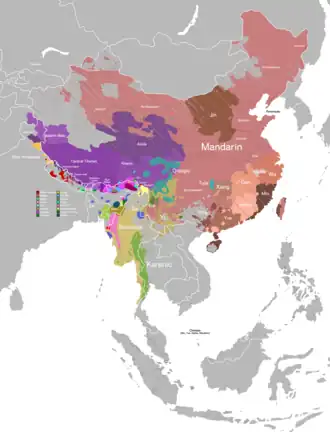Dumi language
| Dumi | |
|---|---|
| Region | Khotang district, Nepal |
| Ethnicity | Dumi kirat. Ethnic population: 7,640 (2011 census)[1] |
| Speakers | Native: 2,500 (2017)[1] L2: 1,000 (2011 census)[1] |
Sino-Tibetan
| |
| Language codes | |
| ISO 639-3 | dus |
| Glottolog | dumi1241 |
| ELP | Dumi |
Dumi is a Kiranti language spoken in the area around the Tap and Rava rivers and their confluence in northern Khotang district, Nepal.[1] It is spoken in the villages such as Makpa, Kharbari, Baksila, Sapteshwor, and Kharmi.
Dialects are Kharbari, Lamdija, and Makpa, with Makpa being the most divergent dialect.[1]
Phonology
| Labial | Dental | Lamino- alveolopalatal |
Alveolar | Dorsal | Glottal | ||
|---|---|---|---|---|---|---|---|
| Nasal | m | n | ŋ | ||||
| Plosive/ Affricate |
voiceless | p | t̪ | t | k | ʔ | |
| voiceless aspirated | pʰ | t̪ʰ | tʰ | kʰ | |||
| voiced | b | d̪ | dz | d | ɡ | ||
| voiced aspirated | bʱ | d̪ʰ | dʱ | ɡʱ | |||
| Fricative | s | h | |||||
| Trill | r | ||||||
| Approximant | w | l | j | ||||
| Front | Central | Back | ||||
|---|---|---|---|---|---|---|
| Short | Long | Short | Long | Short | Long | |
| High | i | iː | ɨ | u | uː | |
| Mid | e | eː | o | oː | ||
| Mid-low | œ | ə | ||||
| Low | a | aː | ||||
| Diphthongs | əj | e:j | ai | oj | o:ə | |
Grammar
Dumi is an ergative-absolutive language. Embedded sentences may take on the ergative case. Subjects of intransitive verbs and patients of transitive verbs take the absolutive case. A transitive verb shows agreement with both agent and patient.
| Case | Suffix |
|---|---|
| Ergative | -(ʔ)a |
| Absolutive | -ø |
| Genitive | -(ʔ)a |
| Locative | -bi, -hoy |
| Comitative | -kəy |
| Ablative | -ləkə, -lam, -kə |
| Comparative | -yikə |
Nominal plurality is denoted by the suffix <-mɨl> and duality by the suffix <-nɨ>. The plural suffix precedes the ergative and most case endings.
Personal pronouns distinguish between three persons, three numbers, and between inclusive and exclusive. Third person -ɨm denotes only human referents. tom 'this' and mom 'that' can refer to non-human third person subjects. Additionally, aŋ, an, ɨm, and hammɨl have possessive prefixes o:-, a-, ɨ-, and ham-, respectively. The pronouns abo 'who', mwo: 'what', hempa 'where' and hempo 'which one' occupy the same position as their corresponding non-interrogative pronoun would occupy.
| Person | Singular | Dual | Plural | ||
|---|---|---|---|---|---|
| Incl. | Excl. | Incl. | Excl. | ||
| 1 | aŋ | intsi | antsɨ | iŋki | aŋkɨ |
| 2 | an | antsi | ani | ||
| 3 | ɨm, tom, mom | ɨmnɨ, ɨntsi | hammɨl, ɨmmɨl | ||
The default word order is Subject-Object-Verb.
Attributive forms of numerals 1-9 use the numeral classifier -bo, while the attributive forms of other numerals are unmarked. The interrogative pronoun hittakbo 'how many' also carries this classifier.
| Numeral | Dumi | Numeral | Dumi |
|---|---|---|---|
| 1 | tɨk | 6 | mu |
| 2 | sak | 7 | sɨm |
| 3 | ryek | 8 | ɨm |
| 4 | tɨm | 9 | nu/dek |
| 5 | ŋo | 10 | tɨksi |
See also
References
- ^ a b c d e Dumi at Ethnologue (25th ed., 2022)

- ^ Driem, George van (2011-07-22). A Grammar of Dumi. Walter de Gruyter. ISBN 9783110880915.
External links
